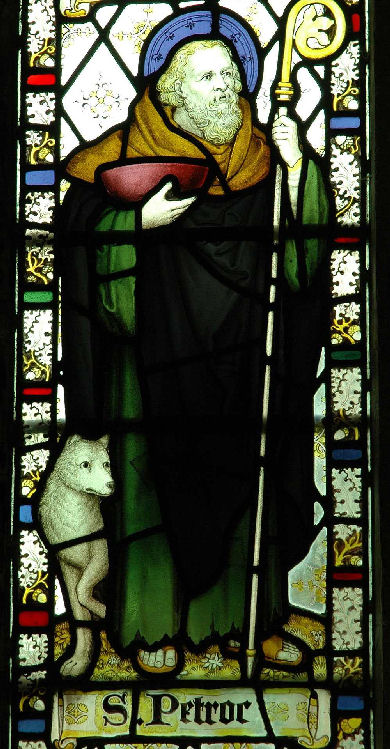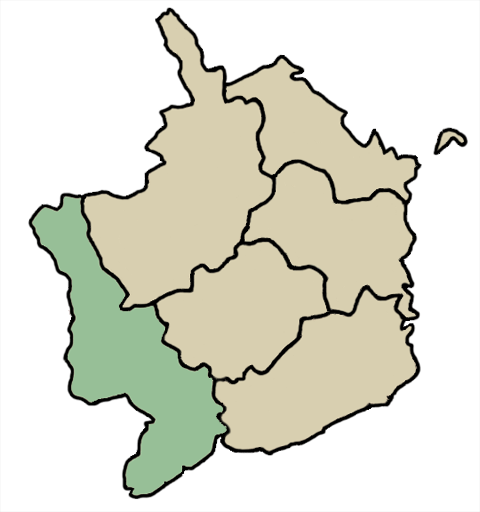|
Gwynlliw
Gwynllyw Filwr or Gwynllyw Farfog (), known in English in a corrupted form as Woolos the Warrior or Woolos the Bearded ( la, Gundleus, Gundleius or Gwenleue; 450 – 500 AD) was a Welsh king and religious figure. He was King of Gwynllwg in South Wales and is the legendary founder and patron saint of the City of Newport living around the 5th century. According to medieval tradition he was a feared warlord and raider who knew King Arthur, but later found religion and became a hermit founding St Woolos Cathedral in Newport. He was the father of one of the most revered Welsh saints, Saint Cadoc the Wise. Traditional history The medieval lives of Saint Cadoc (c. 1100) by Lifris and of Saint Gwynllyw (c. 1120)'Vita sancti Gundleii', Vitae sanctorum Britanniae et genealogiae, ed. A. W. Wade-Evans (1944), 172–93 preserve legendary details of Gwynllyw, though details frequently differ. He is also noted in Welsh king lists. The saint's lives note that his deeds were celebrated by Wels ... [...More Info...] [...Related Items...] OR: [Wikipedia] [Google] [Baidu] |
Cadoc
Saint Cadoc or Cadog ( lat-med, Cadocus; also Modern Welsh: Cattwg; born or before) was a 5th–6th-century Abbot of Llancarfan, near Cowbridge in Glamorgan, Wales, a monastery famous from the era of the British church as a centre of learning, where Illtud spent the first period of his religious life under Cadoc's tutelage. Cadoc is credited with the establishment of many churches in Cornwall, Brittany,''Martyrologium Romanum'', 2004, Vatican Press (Typis Vaticanis), page 529. Dyfed and Scotland. He is known as ''Cattwg Ddoeth'', "the Wise", and a large collection of his maxims and moral sayings were included in Volume III of the Myvyrian Archaiology. He is listed in the 2004 edition of the Roman Martyrology under 21 September. His Norman-era "Life" is a hagiography of importance to the case for the historicity of Arthur as one of seven saints' lives that mention Arthur independently of Geoffrey of Monmouth's ''Historia Regum Britanniae''. Biography Cadoc's story appears ... [...More Info...] [...Related Items...] OR: [Wikipedia] [Google] [Baidu] |
Eastern Orthodox Church
The Eastern Orthodox Church, also called the Orthodox Church, is the second-largest Christian church, with approximately 220 million baptized members. It operates as a communion of autocephalous churches, each governed by its bishops via local synods. The church has no central doctrinal or governmental authority analogous to the head of the Roman Catholic Church—the Pope—but the Ecumenical Patriarch of Constantinople is recognized by them as '' primus inter pares'' ("first among equals"), which may be explained as a representative of the church. As one of the oldest surviving religious institutions in the world, the Eastern Orthodox Church has played a prominent role in the history and culture of Eastern and Southeastern Europe. The Eastern Orthodox Church officially calls itself the Orthodox Catholic Church. Eastern Orthodox theology is based on holy tradition, which incorporates the dogmatic decrees of the seven ecumenical councils, the Scriptures, and the teachin ... [...More Info...] [...Related Items...] OR: [Wikipedia] [Google] [Baidu] |
Glamorgan
, HQ = Cardiff , Government = Glamorgan County Council (1889–1974) , Origin= , Code = GLA , CodeName = Chapman code , Replace = * West Glamorgan * Mid Glamorgan * South Glamorgan , Motto = ("He who suffered, conquered") , Image = Flag adopted in 2013 , Map = , Arms = , PopulationFirst = 326,254 , PopulationFirstYear = 1861 , AreaFirst = , AreaFirstYear = 1861 , DensityFirst = 0.7/acre , DensityFirstYear = 1861 , PopulationSecond = 1,120,910Vision of Britain �Glamorgan population , PopulationSecondYear = 1911 , AreaSecond = , AreaSecondYear = 1911 , DensitySecond ... [...More Info...] [...Related Items...] OR: [Wikipedia] [Google] [Baidu] |
Patron Saint
A patron saint, patroness saint, patron hallow or heavenly protector is a saint who in Catholicism, Anglicanism, or Eastern Orthodoxy is regarded as the heavenly advocate of a nation, place, craft, activity, class, clan, family, or person. In Christianity Saints often become the patrons of places where they were born or had been active. However, there were cases in Medieval Europe where a city which grew to prominence and obtained for its cathedral the remains or some relics of a famous saint who had lived and was buried elsewhere, thus making them the city's patron saint – such a practice conferred considerable prestige on the city concerned. In Latin America and the Philippines, Spanish and Portuguese explorers often named a location for the saint on whose feast or commemoration day they first visited the place, with that saint naturally becoming the area's patron. Occupations sometimes have a patron saint who had been connected somewhat with it, although some of ... [...More Info...] [...Related Items...] OR: [Wikipedia] [Google] [Baidu] |
Breton People
The Bretons (; br, Bretoned or ''Vretoned,'' ) are a Celtic ethnic group native to Brittany. They trace much of their heritage to groups of Brittonic speakers who emigrated from southwestern Great Britain, particularly Cornwall and Devon, mostly during the Anglo-Saxon settlement of Britain. They migrated in waves from the 3rd to 9th century (most heavily from 450 to 600) into Armorica, which was subsequently named Brittany after them. The main traditional language of Brittany is Breton (''Brezhoneg''), spoken in Lower Brittany (i.e., the western part of the peninsula). Breton is spoken by around 206,000 people as of 2013. The other principal minority language of Brittany is Gallo; Gallo is spoken only in Upper Brittany, where Breton is less dominant. As one of the Brittonic languages, Breton is related closely to Cornish and more distantly to Welsh, while the Gallo language is one of the Romance '' langues d'oïl''. Currently, most Bretons' native language is standard French. ... [...More Info...] [...Related Items...] OR: [Wikipedia] [Google] [Baidu] |
Cornish People
The Cornish people or Cornish ( kw, Kernowyon, ang, Cornƿīelisċ) are an ethnic group native to, or associated with Cornwall: and a recognised national minority in the United Kingdom, which can trace its roots to the ancient Britons who inhabited southern and central Great Britain before the Roman conquest. Many in Cornwall today continue to assert a distinct identity separate from or in addition to English or British identities. Cornish identity has been adopted by migrants into Cornwall, as well as by emigrant and descendant communities from Cornwall, the latter sometimes referred to as the Cornish diaspora. Although not included as an tick-box option in the UK census, the numbers of those writing in a Cornish ethnic and national identity are officially recognised and recorded. Throughout classical antiquity, the ancient Britons formed a series of tribes, cultures and identities in Great Britain; the Dumnonii and Cornovii were the Celtic tribes who inhabited what w ... [...More Info...] [...Related Items...] OR: [Wikipedia] [Google] [Baidu] |
Saint Petroc
Saint Petroc or Petrock ( lat-med, Petrocus; cy, Pedrog; french: link=no, Perreux; ) was a British prince and Christian saint. Probably born in South Wales, he primarily ministered to the Britons of Devon (Dewnans) and Cornwall (Kernow) then forming the kingdom of Dumnonia where he is associated with a monastery at Padstow, which is named after him (Pedroc-stowe, or 'Petrock's Place'). Padstow appears to have been his earliest major cult centre, but Bodmin became the major centre for his veneration when his relics were moved to the monastery there in the later ninth century. Bodmin monastery became one of the wealthiest Cornish foundations by the eleventh century. There is a second ancient dedication to him nearby at Little Petherick or "Saint Petroc Minor". In Devon ancient dedications total a probable seventeen (plus Timberscombe just over the border in Somerset), mostly coastal and including one within the old Roman walls of Exeter as well as the villages of Petrockstowe an ... [...More Info...] [...Related Items...] OR: [Wikipedia] [Google] [Baidu] |
Hundred (country Subdivision)
A hundred is an administrative division that is geographically part of a larger region. It was formerly used in England, Wales, some parts of the United States, Denmark, Southern Schleswig, Sweden, Finland, Norway, the Bishopric of Ösel–Wiek, Curonia, the Ukrainian state of the Cossack Hetmanate and in Cumberland County in the British Colony of New South Wales. It is still used in other places, including in Australia (in South Australia and the Northern Territory). Other terms for the hundred in English and other languages include ''wapentake'', ''herred'' (Danish and Bokmål Norwegian), ''herad'' ( Nynorsk Norwegian), ''hérað'' (Icelandic), ''härad'' or ''hundare'' (Swedish), ''Harde'' (German), ''hiird'' ( North Frisian), ''satakunta'' or ''kihlakunta'' (Finnish), ''kihelkond'' (Estonian), ''kiligunda'' (Livonian), ''cantref'' (Welsh) and ''sotnia'' (Slavic). In Ireland, a similar subdivision of counties is referred to as a barony, and a hundred is a subdivision of a part ... [...More Info...] [...Related Items...] OR: [Wikipedia] [Google] [Baidu] |
Wentloog (hundred)
Wentloog (also known as Wentlloog and Wentllooge) was an ancient hundred of Monmouthshire. It was also known as Newport hundred. It was situated in the western part of the county, bounded to the north by Brecknockshire; on the east by the hundreds of Abergavenny, Usk and Caldicot; on the south by the Bristol Channel, and on the west by Glamorganshire. ''Wentloog'' is an anglicisation of the Welsh ''Gwynllŵg'', the name of the early kingdom and medieval ''cantref''. It contained the following ancient parishes: *Aberystruth *Bassaleg: consisting of Duffryn township, Graig hamlet and Rogerstone township *Bedwas *Bedwellty * Bettws *Coedkernew * Henllys * Llanfihangel Llantarnam * Llanhilleth *Machen * Malpas * Marshfield *Michaelston y vedw *Mynyddislwyn * Newport *Peterstone Wentlooge *Risca * Rumney *St. Brides Wentlooge * St. Mellons * St. Woolos The area is now administered by several local authorities, in particular Newport, Torfaen, Blaenau Gwent and Caerphi ... [...More Info...] [...Related Items...] OR: [Wikipedia] [Google] [Baidu] |
Cantref
A cantref ( ; ; plural cantrefi or cantrefs; also rendered as ''cantred'') was a medieval Welsh land division, particularly important in the administration of Welsh law. Description Land in medieval Wales was divided into ''cantrefi'', which were themselves divided into smaller ''cymydau'' (commotes). The word ''cantref'' is derived from ''cant'' ("a hundred") and ''tref'' ("town" in modern Welsh, but formerly used for much smaller settlements). The ''cantref'' is thought to be the original unit, with the commotes being a later division. ''Cantrefi'' could vary considerably in size: most were divided into two or three commotes, but the largest, the ''Cantref Mawr'' (or "Great Cantref") in Ystrad Tywi (now in Carmarthenshire) was divided into seven commotes. History The antiquity of the ''cantrefi'' is demonstrated by the fact that they often mark the boundary between dialects. Some were originally kingdoms in their own right; others may have been artificial units created later. ... [...More Info...] [...Related Items...] OR: [Wikipedia] [Google] [Baidu] |
Cunedda
Cunedda ap Edern, also called Cunedda ''Wledig'' ( 5th century), was an important early Welsh people, Welsh leader, and the progenitor of the Royal dynasty of Kingdom of Gwynedd, Gwynedd, one of the very oldest of western Europe. Name The name ''Cunedda'' (spelled ''Cunedag'' in the AD 828 pseudo-history ''Historia Brittonum'') derives from the Common Brittonic, Brythonic word ', meaning "Good Hound/Warrior" or "Having Good Hounds/Warriors". Genealogy His genealogy is traced back to a grandfather living in late Roman Britain named Padarn Beisrudd. His name literally translates as Paternus of the "red tunic" or the Paludamentum, scarlet cloak, a color attributed to Roman officers during the Roman Empire. One traditional interpretation identifies Padarn as a Roman_people#Late_antiquity, Roman (Romano-British) official of reasonably high rank who had been placed in command of the Votadini troops stationed in the Clackmannanshire region of Scotland in the 380s or earlier by th ... [...More Info...] [...Related Items...] OR: [Wikipedia] [Google] [Baidu] |
Macsen Wledig
Magnus Maximus (; cy, Macsen Wledig ; died 8 August 388) was Roman emperor of the Western Roman Empire from 383 to 388. He usurped the throne from emperor Gratian in 383 through negotiation with emperor Theodosius I. He was made emperor in Britannia and Gaul the next year while Gratian's brother Valentinian II retained Italy, Pannonia, Hispania, and Africa. In 387, Maximus's ambitions led him to invade Italy, resulting in his defeat by Theodosius I at the Battle of Poetovio in 388. In the view of some historians, his death marked the end of direct imperial presence in Northern Gaul and Britain. Life Birth, army career Maximus was born in Gallaecia, on the estates of Count Theodosius (the Elder) of the Theodosian dynasty, to whom he claimed to be related.J. B. Bury ed. (1924)''The Cambridge Medieval History'' p. 238 Maximus was a distinguished general; he was probably a junior officer in Britain in 368, during the quelling of the Great Conspiracy. He served under Count Theodos ... [...More Info...] [...Related Items...] OR: [Wikipedia] [Google] [Baidu] |






.jpg)


.jpg)
_A_king%2C_possibly_Magnus_Maximus%2C_holding_a_sceptre.jpg)